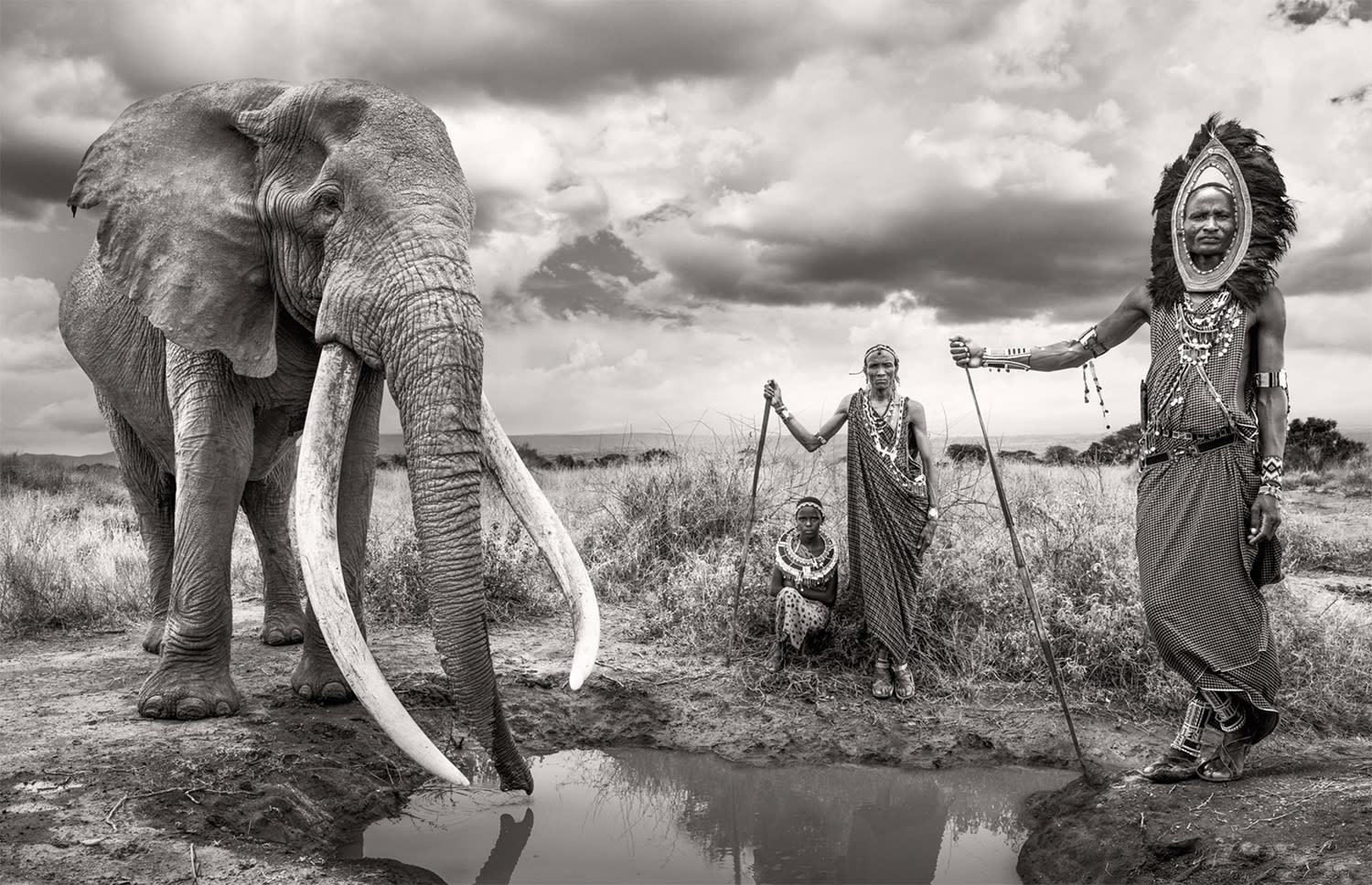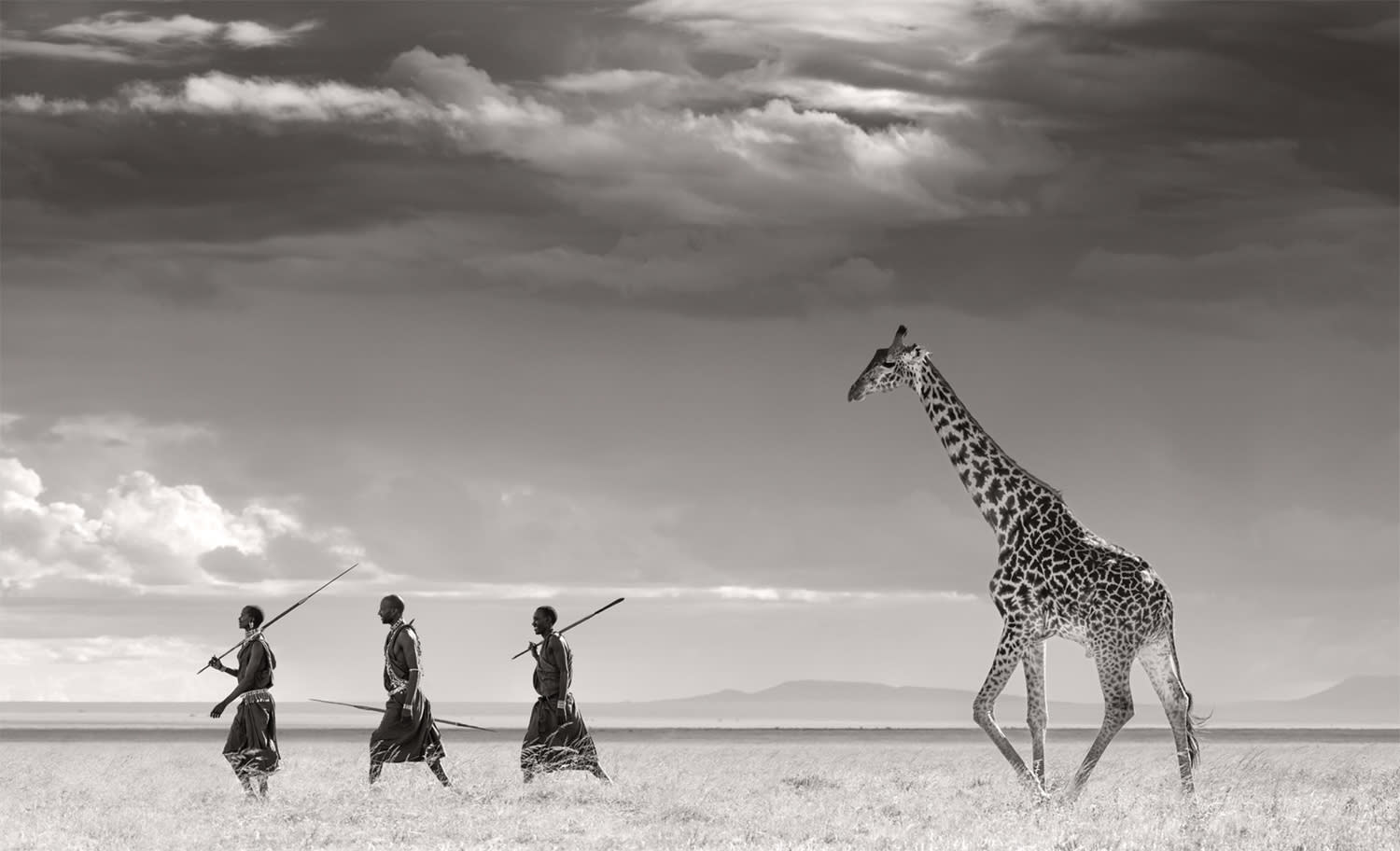
In an era where technology dominates daily life and the natural world often feels distant, photographer James Lewin invites us to look again. His latest series fuses the traditions of portraiture with the rawness of wildlife photography, creating composite images that unite Maasai tribespeople with East Africa’s most iconic animals. Each work is at once a technical feat and a cultural record, reminding us that humanity and nature remain deeply interwoven.
The Maasai are a semi-nomadic people who have lived for centuries across the grasslands of Kenya and northern Tanzania. Renowned for their cattle-based way of life, distinct dress, and profound spiritual connection to the land, they are among the most recognizable and respected cultures in East Africa. For Lewin, their ancestral role as stewards of much of the region’s wilderness made them the natural subjects through which to explore coexistence between people and wildlife.
This series was not achieved quickly or easily. It unfolded over three years, requiring Lewin to spend weeks at a time waiting for wild animals to align with his vision, before returning to the exact same spot, sometimes months or even a year later, with his human subjects. Every frame demanded precision: the same camera position, the same lens, the same light and weather conditions, in landscapes where nothing can be controlled. It is, as Lewin describes, the most technically complex project he has ever undertaken, one that demanded patience, finesse, and unwavering dedication to authenticity.
We sat down with Lewin to discuss his inspirations, the process behind the work, and what it means to honor both wildlife and culture through art.

“We are not separate from nature, we are not above it. We are very much part of it.”
Q: When people encounter this new series for the first time, what do you hope they feel?
Lewin: I want people to be reminded that we are part of nature as well. We are not separate from it, we are not above it, we are very much part of it. I want people to be drawn to the harmony between the humans and the animal subjects. This is a series about celebrating the beauty of these cultures as well as the iconic wildlife we know and love. I hope people feel that connection between the two and are moved by it.
Q: You have spent your career photographing wildlife. How different was it to include human subjects for the first time?
Lewin: This project was completely new to me. I have never photographed human portraiture before. My normal work is about trying to draw a connection between the viewer and the animal. Suddenly, for this series, I was capturing wildlife over multiple years to make it look like the animals were interacting with a human who was not there. That was one of the biggest challenges.
And then, of course, there is the human portraiture side, which is new to my photography. I have always been purely a wildlife photographer. But I have always been drawn to the fine art style, and I think this is a natural step, part of the story I am living here in Kenya. Spending so much time in the wilderness, I have realized that these incredible cultures are just as endangered as the wildlife. That is something I have seen firsthand, and it is really scary. You have to go far into the bush, far off any tourist map, to find people living as they did hundreds of years ago, completely connected, sharing their land with wildlife. So even though I had not photographed humans before, this story felt natural to me.
Much of East Africa’s wilderness, and its best-known safari destinations, are Maasai ancestral lands. For Lewin, starting this series with them was not just an artistic decision but a necessary one. Their way of life is inextricably tied to the landscapes and species his work has always celebrated.

“They stood proudly, like a lion on a rock, revealing their character in the purest way.”
Q: What struck you most about photographing the Maasai?
Lewin: Something that really moved me was the way they revealed themselves for the photographs. It was extraordinary. They needed no direction. All I wanted was for them to reveal their personalities, their character, and they did that so naturally.
Because they have not been influenced by what we see every day, social media, films, advertising, they have never seen those poses. So it was so moving to watch them stand proudly, like a lion on a rock, and just reveal themselves. I almost did not have to ask them to do anything. That was really special for me to witness.
For Lewin, this purity was revelatory. The Maasai brought no performance, no learned poses, no hesitation in front of the lens. Instead, they offered something closer to essence, the kind of unmediated presence that portraitists often chase but rarely find. Their pride and stillness recall the very animals with which they share their lands.
Q: Did you expect to enjoy photographing people? Do you see yourself doing more of it?
Lewin: I am definitely not done with this story, and I am very excited to see how people respond to it. I think it is an important story coming at an important time, because there simply is not enough space for humans and animals to be completely separate and both still thrive. A coexistence model is key. If we are going to share this planet with these incredible species, we need to learn how to share the land. And the Maasai are one of the tribes in Africa that offer a compelling example of that.
As for the photography side, I did not expect to enjoy it as much as I did. With animals, it can take weeks of following an individual, waiting for the right things to happen, the right sky, the right setting. With humans, you can take them to the place. That was wonderful, and it is definitely something I will repeat. I would love to spend more time with different tribes across East Africa and beyond, and see where it takes me. Certainly, this is a new passion revealing itself.
Lewin now speaks of portraiture in the same terms he once reserved for his lions, elephants, and rhinos. “It is all portraiture,” he says, each subject deserving intimacy and respect, whether human or animal. What began as a technical challenge has opened a new path in his practice.

Q: How do the Maasai embody coexistence with wildlife?
Lewin: The Maasai came down from what is today South Sudan in the 15th or 16th century. Since then, they have lived a semi-nomadic lifestyle based around their cattle. For hundreds of years, they have lived in untouched wilderness, grazing their cows among other grazing animals, following the rains just as the wildlife does.
They have shared the same grasslands and water sources with wild animals. They do not eat bush meat. Many trees are sacred to them, and for firewood they will use elephant-damaged wood or dead trees. They are highly connected to the world around them.
I think that is inspiring. Wherever we live in the world, there is still incredible nature outside our doors. To live long into the future, for our generations to thrive, we need to find a way to coexist and reconnect with nature.

“The Maasai show us that human flourishing need not come at nature’s expense.”
The Maasai’s ethos reflects an ancient environmental ethic: survival through balance rather than dominance. Their customs, from sacred trees to their refusal of bush meat, are reminders that human flourishing need not come at nature’s expense. In an age of ecological crisis, Lewin sees their example as both a warning and a guide.
Q: Can you walk us through how you made one of these images?
Lewin: Every artwork is made from two separate photographs, one of the animal, one of the Maasai subject, captured in the exact same location, with the same lens, at the same time of day, and under the same conditions.
Take the image of the male lion proudly standing on a rock with a Maasai warrior to the side and a bird on the left. That was a very special image for me. I had been spending 30 or 40 days in that area trying to capture a lion in that exact position. When it finally happened, I had to choose: do I take this for my normal wildlife work, or do I stay true to this series? I saw it was the perfect place to bring a human subject, so I stayed the course. The first step was always capturing the wildlife. That meant three years of trips focused on photographing animals as if the human was already there. Then came building relationships with the Maasai, taking them to those same places for portraits, and finally layering the images. The camera had to be in the exact same spot, under the same conditions, for everything to align. Sometimes it took me three hours just to match the camera position. Some frames were a year apart.
There were far easier ways to do this. But for me, authenticity was non-negotiable. I wanted real wild animals and real Maasai warriors from the same region. That is what makes this series real.
In an era when AI composites and staged photography are everywhere, Lewin insists on the discipline of fieldwork. The images may appear seamless, but each is a composite forged from patience, proximity, and precision. The effect is both haunting and incontrovertibly real.
Q: Were there surprises along the way?
Lewin: Yes. Shooting in the wild allowed for unexpected things to happen. In that lion-and-warrior image, a superb starling flew past the warrior during the second exposure. It was not there in the original lion image, but because I was working for real, that bird became part of the story. Those moments made the project a joy. They brought new elements to the images that I could never have planned.
These chance interventions, a bird, a shift of light, a sudden gesture, remind Lewin why working in real landscapes matters. His collaborators are not just human and animal, but the wild itself.
Q: After three years on this project, what stays with you most?
Lewin: The friendships. During the weeks I spent with the Maasai, they welcomed me with warmth, shared stories around the fire, and gave me a sense of belonging. Some have become true friends. This series is a reflection of that experience. It is a reminder that we are not separate from nature, not above it, but part of it. The Maasai embody this truth, and I hope these portraits remind people that coexistence is not only possible, it is essential.

As we wrapped up our conversation, it’s clear that for Lewin, the work is not just technical mastery but lived experience. It carries the memory of evenings by the fire, of trust built in the bush, of belonging found in community. Each image is as much about human relationships as it is about composition.
This newest series, a culmination of years of patience, precision, and partnership, serves as both an artistic achievement and a cultural document. It asks us to reconsider our place in the natural world, not as outsiders, but as participants. Each portrait is a testament to the idea that humanity and the wild can still thrive together, side by side, as they always have. These truly are portraits of coexistence.
